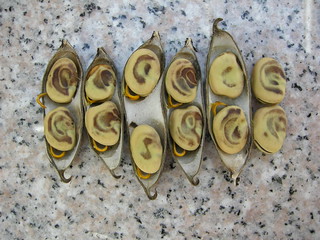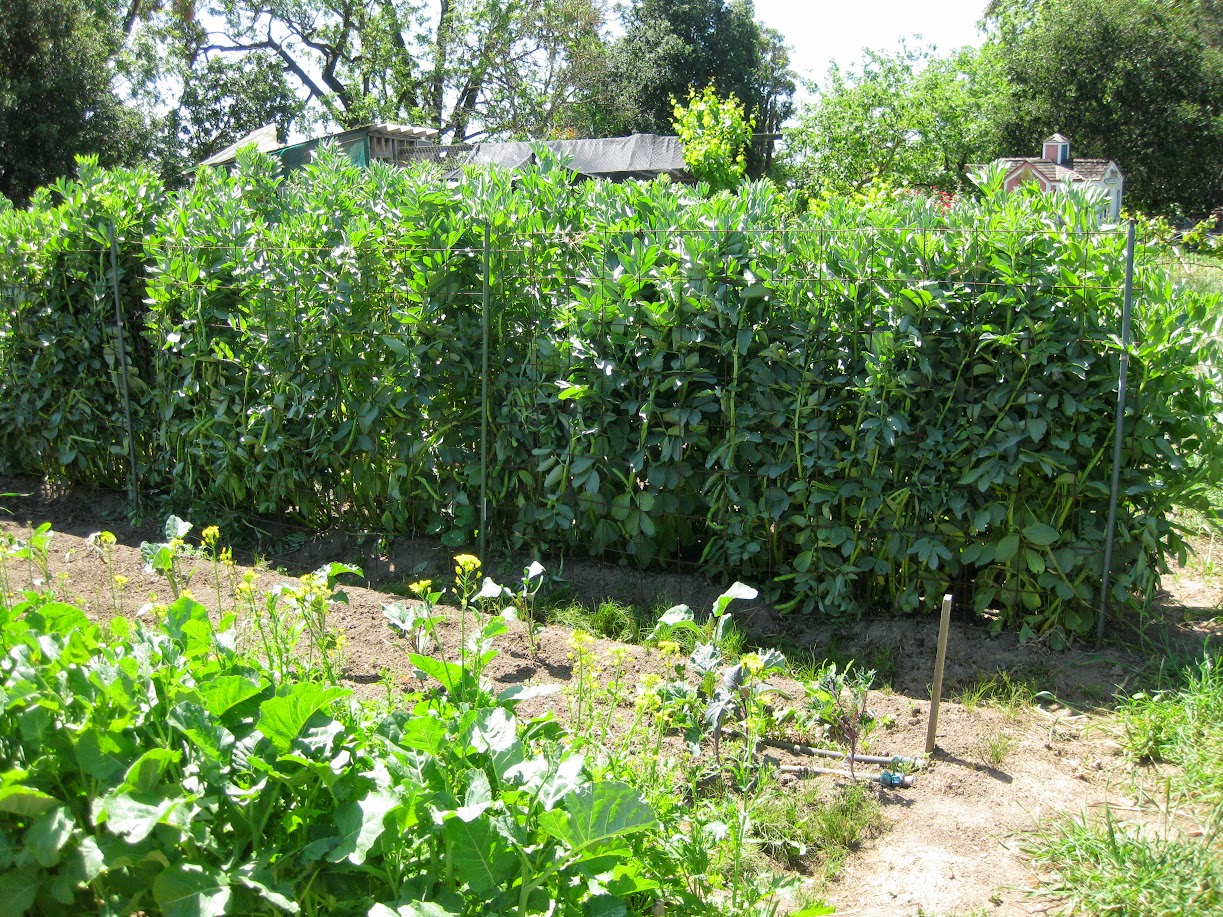|
|
Post by flowerweaver on Jun 27, 2014 11:28:15 GMT -5
And this harvest was even pre-tornado! |
|
|
|
Post by petitvilaincanard on Jun 28, 2014 16:10:31 GMT -5
Over here the june was very dry.No problem for the favas because anyway they are ripening/drying during this month The patch infront of the greenhouse was in this stage the 12 june.A part of it I picked green for eating and a lot in freezer. Imostly take all the green beans from a plant and destroy it,so I can plant a summer crop.Astronomy domine sweet corn in this case. Here the left over plants for dry beans are close to ripening.  here (maybe) you can see some baby AD plants in the place of the destroyed favas  and here the same patch 28 june,the dry beans collected, ad sweet corn is busy taking over with green hokkaido squash ready to fill up any free space.In this patch I try to realise my version of perma culture.With possible two crops a year.  Now to the extra cold resistant. They look really different.12 june   28 june  Then I threw in some turnip seed and picked the beans,breaking the stalks as much as I could  Will this work?? we'll see Anyway some volunteer foddercabbage plants were ready to take over in a patch on a place that had seeding fodder cabbage before.If nature can do it by it self,it can be done with my help too. Next year I'll throw in seed (cabbage,leeks,turnips)early in spring in the fava patches.  The situation in the green house....  I'm not finished with those favas |
|
|
|
Post by philagardener on Jun 28, 2014 19:07:03 GMT -5
The situation in the green house....  I can see mice must not be a problem! :>) |
|
|
|
Post by Joseph Lofthouse on Jun 29, 2014 13:06:05 GMT -5
petitvilaincanard: Thanks for photos of favas. It's nice to see how well they grow in the proper climate with a farmer that knows how to grow favas... Wow! That's a lot of pods per plant!!! I counted pods on a different fava patch yesterday. They seem done flowering for the year. There were 28 surviving plants that produced 14 seed pods between them. Only about 1/4 of the plants produced pods. One plant (looks like a pigeon bean) produced 5 pods.
|
|
|
|
Post by robertb on Jul 2, 2014 14:35:33 GMT -5
Mine are still flowering. Direct planted ones have done better than transplanted, and should produce a lot more pods. There's a lot of blackfly, but it doesn't seem to be inhibiting any of the plants at all. I had some trouble with rats eating the beans, but poison seems to have sorted that out. As long as they keep out of my beehives!
|
|
|
|
Post by Joseph Lofthouse on Jul 13, 2014 22:43:15 GMT -5
I harvested a few Fava beans this week. Looks like more are on the way. I'm anticipating that this will be the first year that I harvested more seed than was planted.  |
|
|
|
Post by steev on Jul 13, 2014 23:41:43 GMT -5
Those black ones are striking.
Mine have all gone to a better place; sic transit faba.
|
|
|
|
Post by blueadzuki on Jul 28, 2014 13:55:57 GMT -5
Fava beans can have seed coat patterns:  , since you never gave the name of that variety, is is possibly "Ojo de Dios"? I just got some seed of that from Sacred Succulents, and it seems to be the spitting image of yours. |
|
|
|
Post by toad on Jul 29, 2014 15:15:48 GMT -5
I never got a cultivar name, and anyway, they had crossed with other favas before I was given the seeds, asked to restore the pattern. When stabilized, mine will ha e become a new cultivar, but until then I recognize it as breedi g material.
Very interesting with a cultivar name, that probably is the origin of my material. Thanks for posting that!
|
|
|
|
Post by petitvilaincanard on Aug 10, 2014 16:34:22 GMT -5
This is the stuff from this year.  from left to right 1)extra cold resistant feverole,"grexed" with "cote d'or"feverole(the black feveroles are very probable crosses with cote d'or. 2) and 3) extra cold resistant 4)extra cold resistant selection. collected from 4 or 5 plants with pending pods.these are either back crosses to big seeded favas or segregation within the extra cold resistant population. 5)semi cold resistant grexed with kapulers "iantos return" 6)dumont/nuts grex,big favas without any selection for cold resistance. What i call "extra cold resistant is the progeniture of the 0.5% survival of a very cold period(minima between -10 and -15 C for 15 days without snowcover)Among those survivors were surely crosses between feveroles and big favas semi cold resistant is the progeniture of 25% survival of a similar cold period but with snowcover. This is the second generation after the very cold winter,but such a cold winter is a very exception over here. So it would be great if these populations could be tested in regions with cold winters. In the ideal case a big seeded ,or at least a medium sized (let's call that fevettes,good idea) "variety" could be developped,stabilized for resistance to cold winters.If ever these populations contain the genetics that make it possible. If some one want to try my favas for such a project pm me Or if you want some of my seeds just for fun ,no problem,ask. |
|
|
|
Post by Joseph Lofthouse on Mar 7, 2015 19:42:10 GMT -5
I started fava beans in the greenhouse this year. I planted half of them out today. I took a clue from the photos by petitvilaincanard and planted them in a bed this year instead of a row. This is about a month earlier than last year. It's been a precocious season.  The other half are being saved to be planted into a different field next week.  |
|
|
|
Post by templeton on Apr 13, 2015 21:24:13 GMT -5
I'm about to plant a mixed fava plot - AllyH sent me some red flowered, which will be planted with my mixed seed from last year, that may or may not have crossed - I can't remember. Might just sow everything in the seed store and see what happens. The Chocolate Flowered I planted last year did very poorly, so I'm hoping they have crossed into the mixed varieties that were growing along side.
T
|
|
|
|
Post by steev on Apr 13, 2015 22:29:28 GMT -5
My Spring-sown bulk-bin favas (prolly Windsor) are looking up, ~12" tall and blooming profusely; this Winter, I prolly could've planted in Fall, it having been uncommonly un-cold; in a normal year, they'd have been freeze-fried. I hate to think this is the new normal, but next Fall I'll plant, just in case; it's not like the seed costs much and whatever grows without needing irrigation is a good thing.
I'm thinking Fall-planted peas, lentils, and garbanzoes, too. Teparies have been fried by recent cold winds, having sprouted very poorly, anyway.
|
|
|
|
Post by 12540dumont on Apr 14, 2015 12:25:55 GMT -5
 Beans are on! I planted beans three times this year. Halloween, Thanksgiving and Christmas. The Halloween ones are what we are looking at. The Thanksgiving ones are a foot shorter. The ones from Christmas are only knee high, but perfect for tilling in. The fence is 32" high. So yes these are about 4' tall. This is the Foothill Farm grex, thanks to everyone who contributed beans. Southern Exp Fava Windsor Suzanne Ashworth Crimson Flowered Franchi Supersimonia Peace Seeds Longpod Major Cortona H.D. Novoli. Oxbow Norka Very Large Solstice Seeds Loreta Templeton Nameless Dwarf Gippsland Giant Adapative Seeds Ianto’s Return USDA PI 284345 - Piacentino PI 284346 - Pugliese PI 284349 - Siciliana PI 319901 - Khmelnichkie PI 319902 - Prausmitzer Pferdi PI 358262 - Valandoska I have left the bottom pod on each one of these for seed collection later. (I have 7 quart jars in my file cabinet!) We've been eating them in Falafel all winter. Yes they take a long time to soak, overnight, and yes you still have to slip the skins. But they are yummy. And the gophers ate all the chick peas/garbanzos. |
|
|
|
Post by jondear on Apr 14, 2015 14:54:28 GMT -5
Very nice!!
|
|